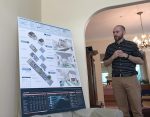Travis Hanks of Haeccity Studio Architecture. He and his colleague Shirley Shen made a presentation at the launch of CoHo on May 12. (photo by Noam Dolgin)
A diverse group of people a couple of dozen strong, all looking for solutions to Vancouver’s housing crisis, met on May 12 to brainstorm and learn. The meeting was organized by CoHo BC, an organization founded by Jewish community member Noam Dolgin, which describes itself as “an initiative to support, encourage and simplify collaborative ownership of property in B.C.”
The gathering took place at the home of Celia Brauer, another Jewish Vancouverite who herself is looking at co-housing options. “I have been loving this house and surrounding green space for 18 years now,” she said in the press release about the meeting. “I would very much enjoy sharing this corner of paradise with someone, especially since it would allow me to remain here.”
After getting to know one another a bit, smaller groups were formed to share ideas of their ideal dwellings and produce a collaborative vision for a home that included them all.
It was clear that everyone present had already given the idea some thought. One team envisioned a shared home with a combination of private areas and shared spaces – such as a library, places where people could work and places kids could play, plus a carport for a shared vehicle – as well as a backyard. (All three mini-groups dropped the idea of a front yard as an unneeded encumbrance.) The other two teams came up with different visions: one imagined private houses sharing courtyards and outdoor spaces on the same lot; another saw a shared structure with self-contained living spaces within it.
Following this exercise, architects Travis Hanks and Shirley Shen of Haeccity Studio Architecture made a presentation on the firm’s Micro-op concept, which won the Urbanarium Missing Middle Competition. (Urbanarium is a registered nonprofit founded by a group of architects, planners and others committed to re-imagining the city.)
Haeccity’s “missing middle” project is about providing alternatives to houses on the one end, and high-rises and condos on the other. Hanks and Shen are exploring ways to increase density on lots that are in the “buffer zones” of major arterials, between single-family neighbourhoods and commercial areas.
Hanks and Shen described the concept: a three-storey building of six or seven housing units that would fit onto a single-family lot of about 33 feet by 122 feet without impinging on the space or esthetic values of adjacent single-family homes. It could be in two buildings, separated by a common courtyard, with the flexibility of a combination of one-, two- and three-bedroom units ranging in size from 525 square feet to 1,350 square feet.
Haeccity’s proposal imagines new urban policies that would provide both more affordable housing and more community-rich neighbourhoods. The housing would be purchased like in a co-op model, where tenants would buy shares in the community. Although this would make buying in more affordable, as well as potentially foster community, intergenerational connection and other benefits that come from long-term residents, many of those at the May 12 meeting were concerned about the lower return on investment such a community would entail, should residents decide to leave. Hanks and Shen were clear that there was a trade-off involved.
“If we’re going to get serious about affordability,” said Hanks, “we have to get serious about separating from the market.”
In his presentation on the CoHo project, Dolgin explained, “CoHo aims to be a portal for information. It is also a ‘matchmaking service’ for homeowners, buyers and sellers to find others with complementary housing needs.”
Dolgin said he plans to collect information that will make it easier to understand people’s needs and to connect like-minded people together. Citing a 2016 Ipsos Reid poll – which found that 11% of respondents would consider buying real estate with a friend or business partner and three percent would consider buying with a stranger – he said openness to co-housing is steadily growing in Vancouver, especially among millennials. What is missing, he said, is an infrastructure to help make it happen.
Brauer then briefly outlined the housing offer she would like to make and led interested guests on a tour. She is offering to sell 60% of her property to someone willing to share it so that she can stay within her community, in the neighbourhood she’s known for almost two decades. She would like to build her own small house in the back of the lot. The only access to her envisioned laneway house would be from the front street. In a kind of microcosm of the needs of the larger co-housing community in Vancouver, Brauer’s plan will be dependent both on finding the right shidduch (match) and on the city being willing to accommodate the project.
“The next step for CoHo BC involves building the community through a series of events, social media and networking,” said Dolgin. “We need to work together to spread the word about this organization and this housing type. People in B.C. are constantly searching for community and affordability, so I truly believe collaboration and some form of communal living or co-ownership is a viable option that would appeal to more than 10% of the population. Our job is to create the community and infrastructure to facilitate and encourage this type of housing.”
For more information, visit cohobc.com.
Matthew Gindin is a freelance journalist, writer and lecturer. He is Pacific correspondent for the CJN, writes regularly for the Forward, Tricycle and the Wisdom Daily, and has been published in Sojourners, Religion Dispatches and elsewhere. He can be found on Medium and Twitter.

